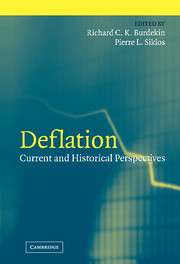Book contents
- Frontmatter
- Contents
- List of Tables and Figures
- List of Contributors
- Preface
- 1 Fears of Deflation and the Role of Monetary Policy: Some Lessons and an Overview
- PART ONE FEARS OF DEFLATION AND THE ROLE OF MONETARY POLICY
- PART TWO DEFLATION AND ASSET PRICES
- PART THREE INTERNATIONAL PERSPECTIVES ON DEFLATION
- PART FOUR STOCK MARKET ADJUSTMENTS TO DEFLATION
- 10 Deflation, the Financial Crises of the 1890s, and Stock Exchange Responses in London, New York, Paris, and Berlin
- 11 The Stock Market and the Business Cycle in Periods of Deflation, (Hyper-) Inflation, and Political Turmoil: Germany, 1913–1926
- 12 Deflationary Pressures and the Role of Gold Stocks: 1929, 1987, and Today
- References
- Index
- Titles in the series
10 - Deflation, the Financial Crises of the 1890s, and Stock Exchange Responses in London, New York, Paris, and Berlin
Published online by Cambridge University Press: 15 December 2009
- Frontmatter
- Contents
- List of Tables and Figures
- List of Contributors
- Preface
- 1 Fears of Deflation and the Role of Monetary Policy: Some Lessons and an Overview
- PART ONE FEARS OF DEFLATION AND THE ROLE OF MONETARY POLICY
- PART TWO DEFLATION AND ASSET PRICES
- PART THREE INTERNATIONAL PERSPECTIVES ON DEFLATION
- PART FOUR STOCK MARKET ADJUSTMENTS TO DEFLATION
- 10 Deflation, the Financial Crises of the 1890s, and Stock Exchange Responses in London, New York, Paris, and Berlin
- 11 The Stock Market and the Business Cycle in Periods of Deflation, (Hyper-) Inflation, and Political Turmoil: Germany, 1913–1926
- 12 Deflationary Pressures and the Role of Gold Stocks: 1929, 1987, and Today
- References
- Index
- Titles in the series
Summary
INTRODUCTION
Since the August 1971 collapse of the Bretton Woods system, financial historians have concluded that there is something almost uncanny about the evolution of the global financial system. They are increasingly struck by the similarities of its origins, the system's continuing stresses, and its occasional setbacks with the origins, stresses, and setbacks that characterized the first global financial system over the years between 1880 and 1914. Both eras arose after a prolonged period of inflation that had disrupted the previous structures of international finance – the outpouring of California gold soon to be followed by the $431 billion (U.S.) in “greenbacks” that were issued to help finance the American Civil War in the earlier period (Dewey 1903: p. 288) and the creation of fiat money to help finance the import of high-priced oil in the later period. Both eras were touched off by a sustained reversal of the previous inflationary experience – deflation in the period 1879 to 1897 and disinflation between 1980 to 1999. Both were, therefore, ultimately the result of a widespread change in monetary regimes – a nearly universal gold standard among the world's richest countries in the first period and a set of monetary rules that restricted the growth of the money supply in the second.
In the two periods, the changes in financial returns – the result of falling bond yields and rising financial asset prices – were both unexpected and significant; and, in each case, they eventually led to a series of financial crises – crises that threatened to become systemic.
- Type
- Chapter
- Information
- DeflationCurrent and Historical Perspectives, pp. 271 - 297Publisher: Cambridge University PressPrint publication year: 2004
- 1
- Cited by



